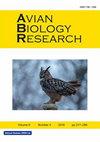朝准确和简单的波内利鹰嘴蝶雏鸟形态的性别区分:种群间变异和生长条件的影响
IF 1.2
4区 农林科学
Q4 AGRICULTURE, DAIRY & ANIMAL SCIENCE
引用次数: 2
摘要
性别分化的形态计量方法可能是分子方法的廉价、简单、快速和可靠的替代方法。然而,在鸟类形态计量方法的使用方面,特别是在其适用于不同种群和环境条件方面,仍然存在重要的不确定性。2004年至2019年间,我们对245只博内利的鹰隼雏鸟进行了采样,其中197只来自加泰罗尼亚(西班牙东北部)和安达卢西亚(西班牙东南部)的巢穴,56只部分或全部圈养。我们的目标是为博内利鹰雏鸟开发基于形态计量学的性别鉴定方法,该方法可原位应用于不同的亚群和生长条件。我们记录了多达九项与筑巢体重、喙、跗骨和爪子长度有关的测量。尾巴和翅膀的长度被用来控制雏鸟的年龄,所有个体都进行了基因性别鉴定。我们发现这两个自然亚群之间存在重要的形态计量学差异。根据我们的判别分析,无论是在野外还是圈养条件下,体重和爪长都是最具判别力的变量。在飞羽生长期,性别差异更为突出。在圈养条件下随意喂食可以使雏鸟更大,并减少性别差异。我们提供了不同的模型来对博内利鹰雏鸟进行性别鉴定,这些模型可以根据所研究的地理位置、生长条件(野生与圈养)以及准确性与简单性之间的平衡进行应用。总的来说,我们的研究结果强调,将性别判别函数外推到不同的亚群和生长条件可能是有风险的。本文章由计算机程序翻译,如有差异,请以英文原文为准。
Towards accurate and simple morphometric sex differentiation in Bonelli’s Eagle Aquila fasciata nestlings: Interpopulation variations and influence of growth conditions
Morphometric methods of sex differentiation may be cheap, simple, quick, and reliable alternatives to molecular approaches. However, there are still important uncertainties regarding the use of morphometric methods in birds, particularly regarding their applicability to different populations and environmental conditions. Between 2004 and 2019, we sampled 245 Bonelli´s Eagle Aquila fasciata nestlings, 197 from nests in Catalonia (northeastern Spain) and Andalusia (southeastern Spain) and 56 that were partially or totally raised in captivity. Our objective was to develop morphometry-based sexing methods for Bonelli’s Eagle nestlings that can be applied in situ to different subpopulations and growth conditions. We recorded up to nine measures related to nestling body mass, bill, tarsus, and claw length. Tail and wing length were used to control for the age of nestlings, and all individuals were sexed genetically. We found important morphometric differences between the two natural subpopulations. According to our discriminant analyses, body mass and claw length were the most discriminant variables, both in wild and captivity conditions. Differences between sexes were more prominent during the flight feathers’ growing period. Feeding ad libitum in captivity conditions led to larger nestlings and reduced between-sexes differences. We provide different models for sexing Bonelli’s Eagle nestlings that can be applied according to the studied geographic location, growth conditions (wild versus captive), and balance between accuracy and simplicity. Overall, our findings highlight that extrapolating sex discriminant functions to different subpopulations and growth conditions may be risky.
求助全文
通过发布文献求助,成功后即可免费获取论文全文。
去求助
来源期刊

Avian Biology Research
农林科学-奶制品与动物科学
CiteScore
1.50
自引率
0.00%
发文量
17
审稿时长
2 months
期刊介绍:
Avian Biology Research provides a forum for the publication of research in every field of ornithology. It covers all aspects of pure and applied ornithology for wild or captive species as well as research that does not readily fit within the publication objectives of other ornithological journals. By considering a wide range of research fields for publication, Avian Biology Research provides a forum for people working in every field of ornithology.
 求助内容:
求助内容: 应助结果提醒方式:
应助结果提醒方式:


